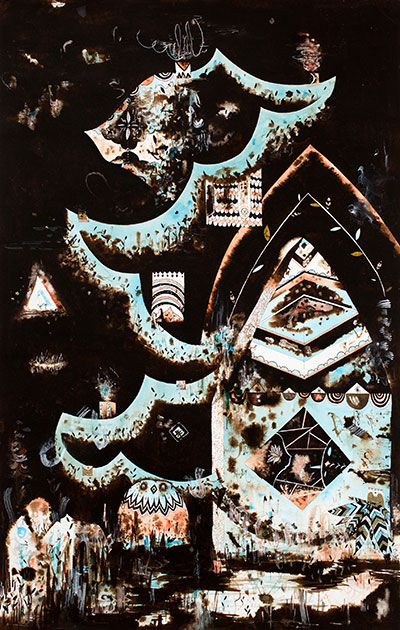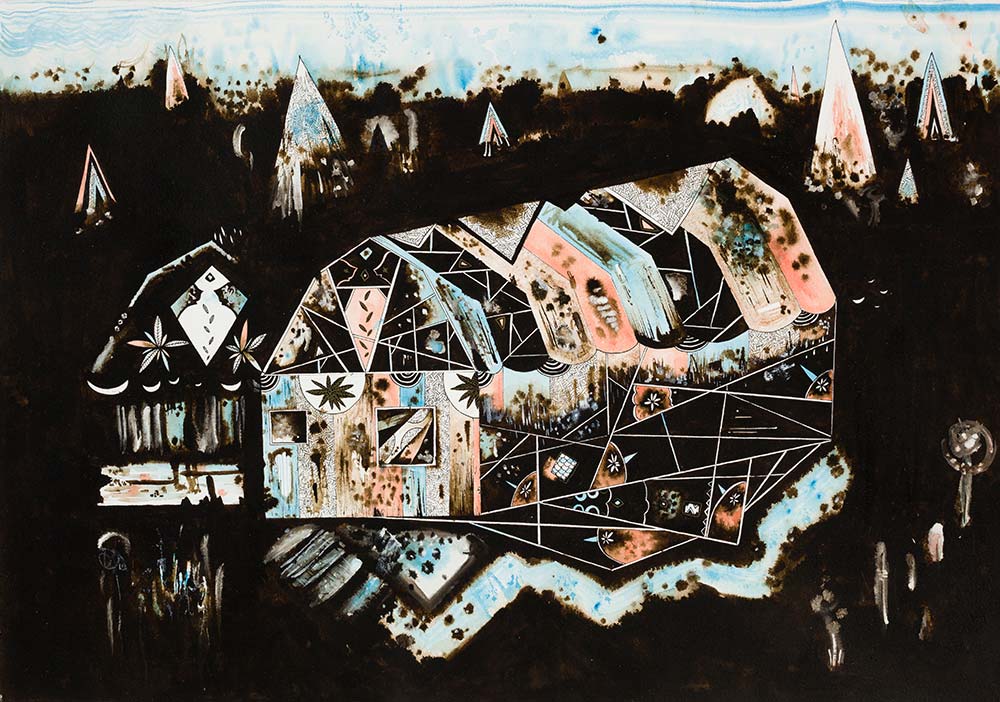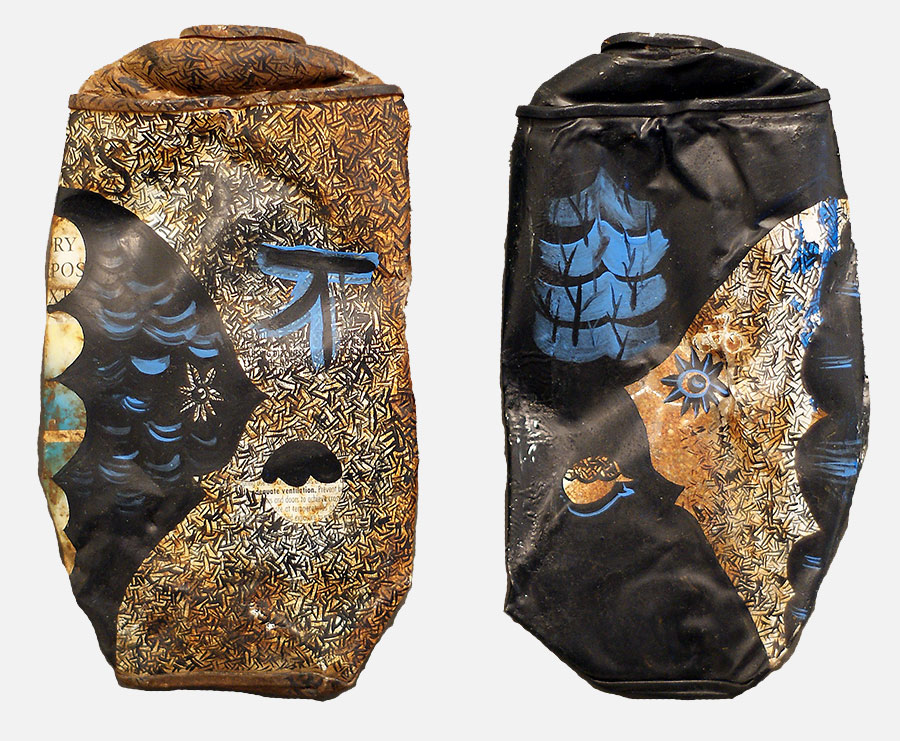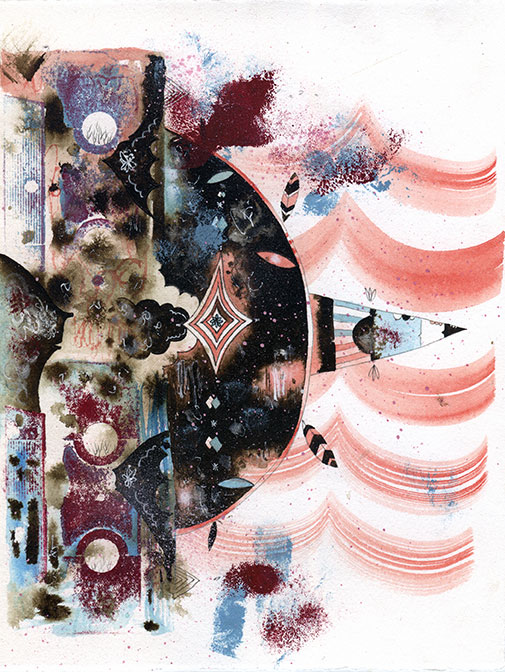With the forests of Indiana as his subconscious muse, Max Kauffman’s paintings illustrate the fissure that divides man and nature. Man might be at his pinnacle, but all empires inevitably crumble. At least Kauffman’s go down gracefully.
What is it about art that drew you in?
Art was a voice when I didn’t always have one. I was kind of a quiet kid so it was a way to communicate. Later in life it was a way to get a lot off my chest. To me it’s akin to meditation in the release it provides.
You started off with ceramics, but decided to focus on drawing and painting. Why did you switch, and have any ideas or concepts carried over?
Ceramics was my first art love. It’s what I got my degree in (along with anthropology, which helped tons down the road) and it was the first medium that allowed me to delve into complex ideas and forms of storytelling. Even then I wondered if painting was a larger interest for me, when I would spend three times as long glazing. Post-school ceramics was challenging to stay with – you need to interact with clay almost daily when producing a piece, and not having a studio brought it to a lull pretty quickly. Painting and drawing served my ADD-brain well: I could start and stop at any moment.
I’ve slowly been getting back into 3-D work in the last few months and hoping to get my fingers dirty in the near future. It’s been a decade! Several ideas carried over to mark-making, the biggest was the idea of a happy accident. Knowing that when you fired something it could be destroyed or that the colors could hinge on minute temperature fluxes helped to make the work a bit less sacred. Concepts of worlds within worlds and texture/buildup came over as well.


Into the Aether
14x21in
Watercolor and Ink on Paper
2013
Do you plan out your pieces or just wing it? How do you attack a blank sheet of paper?
It’s a bit of both. I used to do just free form but I often felt a little cornered. I enjoy working like that, but with the limitations of watercolor/paper as mediums I need a little direction. It’s cheesy but I think of it like jazz (or any music with those leanings) where there are structured areas that bleed into improvisation, and vice versa.
When I start a piece I’m either sketching out some loose guidelines, or straight attacking blank space and then adding in those guidelines after. It’s a little different for each one and that’s what keeps it interesting.


Mountain Retreat,
14x21in
Watercolor and Ink on Paper
2014
What’s the relationship between nature and human life in your post-apocalyptic paintings?
I try and not think of them as post-apocalyptic anymore, but rather different dimensions or alternate realities that occur either earlier or later than the present. When I started, the dynamic between mankind and nature was a struggle – nature taking back its turf from us, fallout from some disaster, giant animal beasts roaming the land and such. But it’s mellowed out over the years. Now it’s more as if man and nature function in tandem, intertwining with one another. It’s more about making due and achieving acceptance, and a return to tribal ways through a culture of the people, not pop. There’s still struggle for sure, but much less so compared to six or seven years ago.
It gives extra power beyond my hands to have the viewer see the work and feel affected. I’m always humbled by what people see in my work.
Do you ever get interpretations of your work that you didn’t expect?
Over the years my direct storytelling in the work has diminished. I’m a way bigger fan of the stories/interpretations/parts of themselves other people bring to the work. It gives extra power beyond my hands to have the viewer see the work and feel affected. I’m always humbled by what people see in my work. There have been girls who have seen their father’s love for Thoreau in there, a fort in the woods behind their childhood home, their spirit animal, grandma’s house, a band they love, all sorts of things. Again that’s more fulfilling to me than conveying my own stories or trying to get something off my chest.


Progress Generator
24x36in
Watercolor, Ink and Enamel on Paper
You mentioned that you had a very adventurous childhood, spending time outside exploring swamps and woods. It’s pretty obvious that this has had a large impact on you and your art. If you had grown up in today’s age, where it seems like kids are turning more to technology over nature, do you think you would be making the same kind of work?
Good question. I’m sure I would’ve found a way, but the time and place of that segue into the digital age really affected me (as well as a giant chunk of my peers who were also kids in the 80s). I think the location (the forests around South Bend, IN) helped a lot too, it was easy to get lost in the wilderness just because there wasn’t a lot to do.
I guess growing up in a somewhat small city and going from there to larger urban environs could still happen to the youth of today right? Just no technology until they’re teens…
What’s the importance of the human quality in art in an increasingly digital age?
I see some really great digital work but it’s so clean, so processed, so filtered. It’s like when a band goes into the studio and they aim for a really slick production and it comes out all … blah. For me it’s human touch, it’s imperfection, it’s changing your mind on the fly, scribbling over mistakes, and it can be messy. Digital seems so safe and censored in comparison. One hopes people will find greater importance in handmade work as we slide deeper into the realm of tech.


In My Little Thatched Hut
19x24in
Watercolor and Ink on Paper
Some of your newer work focuses a lot on homes and structures. What do these symbolize for you, and why are they becoming more and more prominent in your work?
The buildings and architectural elements started as little icons of humanity with animals or beasts as the main focus. They were like a fungus or blight latching on to the– one last hurrah for humanity. As said, the older work was much darker. The first building as a focal point for a painting was finished in early 2012. Under some tough circumstances I had moved out of a house that was very special to me so I wanted to capture the energy and spirit of that place during happier times. The houses are sources of power, like little totems. They represent somewhere to hide from the constant deluge of information/data/chaos that interrupts our day-to-day lives. They’re sanctuaries that soak up anxiety and allow for reset. Some of them are very much of our world, drawn from real places, but there are a few that have come right out of me or the ether. I think of these as temples of the mind – the walls and sanctuaries we build into our brain to honor certain things and to hide others.
Describe the flow of energy that you’ve captured in your paintings.
There’s some meta involved. Painting is a huge release for me, and the houses serve as energy conduits: flowing from them to others, drawing in from their environment, dissolving away into the universe. In my older work I looked a lot at the cyclic nature of life and death, the beauty in something passing yet paving the way for the next generation. I think now that’s more abstracted but still present. Some of the houses might not endure, but they still contain a wealth of power that flows out and causes a rampant floral growth around them, inevitably nourishing the earth. The opposite happens as well. These growths and portals from other places are channeling power into the structures, imbuing them with energy. I enjoy the thought that there’s a type of life force or connected energy between all things.
These growths and portals from other places are channeling power into the structures, imbuing them with energy. I enjoy the thought that there’s a type of life force or connected energy between all things.


Nature vs. Nurture, Mixed Media, 2014
You’ve grown into a very specific color palette; do these colors mean anything to you? Is there a reason you stick to them primarily?
Whenever I go to introduce some new element into my work, the palette is something I think about, and it gradually changes over a year or two. Slow and organically. Coming into the current palette was a long process; I didn’t really have a palette before that. But ultimately it’s fun to work through the restraints of a filter. I found when I zeroed in on a few colors I would play much more with everything else before applying the paint, i.e. building texture, the weight of dry pigments scratches versus big subtle washes and so on. Leaving out more color than I put in also seemed to highlight the smaller areas of pigment, so the weight and placement of color became more important. Lately I’m bringing in or returning to some older colors but they still fit in the limited palette ethos.


21st Century Analog Man
8x10in
Watercolor, Ink and Enamel on Paper
2014
Music has been a huge inspiration for you, and hints of that can be seen throughout your work. What do you usually listen to? Does your soundtrack-of-the-day have any visual effect on what you make?
I notice that if I’m listening to more improvisational music I’ll attack a piece with more abandon, versus an old album that I know inside and out or a podcast I’ll focus on tight details or repetitive passages. What’s playing in the studio is all over the place but I try to have a few albums I’m continuously listening to during month-long intervals. Lately heavy spins have been on a Stones Throw compilation, Soundbombing II, Wilco’s Whole Love, De La Soul’s Mixtape, Liars’ Mess, Foals’ Antidotes and a random show from The Slip in 2004.
What other sources or artists do you draw inspiration from?
Too many artists to list. The great outdoors does a lot, traveling, reading, getting on the ol’ skateboard, history, anthropology, National Geographic, tacos, and banter.
What is something interesting about you that almost no one knows?
My third grade nickname was Toad because I was constantly catching frogs, toads, snakes, salamanders, turtles, etc.
I’m almost afraid to ask, but what is your prediction of what the future holds for us?
All empires crumble. It’s up to us to slow that push…


The Sound of Momentum is So Bittersweet, 22x30in, Watercolor, Ink and Enamel on Paper, 2014
The Neighborhood that Almost Kept, 8x10in, Watercolor and Ink on Paper, 2014
Turn on the Summer, 19x25in, Watercolor, Ink, and Enamel on Paper, 2014